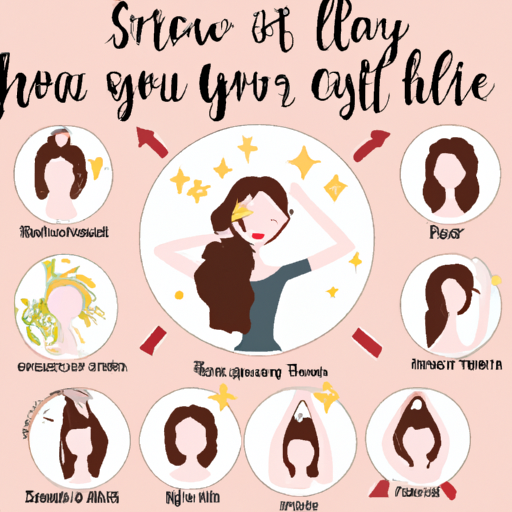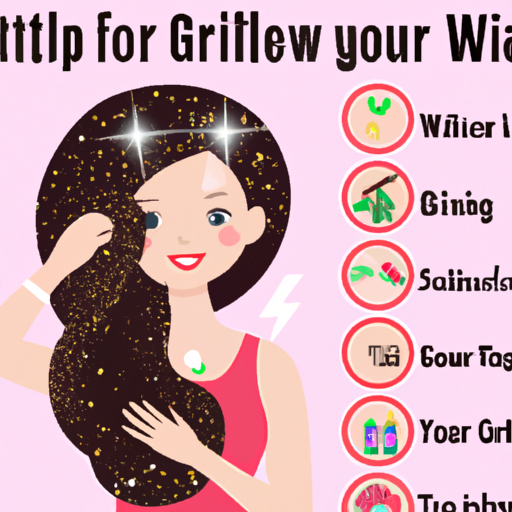Eight Ways To Help Your Hair Grow Faster
This blog post may contain affiliate links that help to fund the My Sparkling Life blog.
How to Make Your Hair Grow Faster
Are you yearning for longer, luscious locks? Growing your hair out can seem like a never-ending journey. However, there are a few techniques you can employ to expedite the process and enhance your hair’s growth. Let’s explore these in-depth.
Get Frequent Trims
Yes, you read it right! Although it may seem counterintuitive, getting regular trims can actually accelerate your hair’s growth. Whether you’re looking to grow African American hair faster or boost the growth of Caucasian hair, trimming off those pesky split ends can prevent further breakage. This leaves your hair looking healthier, smoother, and more voluminous, allowing you to make the most of your existing length.
Avoid Drastic Color Changes
While a new hair color can be exciting, drastic color changes, especially if your hair is naturally dark, can wreak havoc on your hair’s health. Bleaching can damage hair cuticles, leading to increased breakage – the exact opposite of what you want when you’re aiming for longer hair.
Distribute Your Hair’s Natural Oils
Your hair’s natural oils are its best friend. They contribute to its health, but often accumulate at the roots, leading to greasy hair. Regular brushing can help distribute these oils throughout your hair, ensuring all strands benefit. Brushing also stimulates the scalp, promoting hair growth. A boar bristle brush is best for this purpose.
Adopt a Healthier Diet
The secret to long, healthy hair isn’t just the products you apply, but also what you put into your body. Protein-rich foods like fish, beans, nuts, and whole grains are essential for strong, healthy hair. Omega-3, found in oily fish, is also great for hair health. Lack of protein can lead to increased hair shedding, so keep your diet balanced.
Reduce Heat Styling
Heat styling might make your hair look fabulous in the short term, but in the long run, it can lead to hair breakage. Try to limit heat styling and allow your hair to air-dry when possible. If you must use heat, always apply a heat protection spray or serum first.
Don’t Shampoo Daily
While cleanliness is key, shampooing too often can strip your hair of its natural oils. Try to wash your hair only two or three times a week. This gives the oils time to penetrate your hair, improving its overall health.
Take a Multivitamin
Opt for a multivitamin specifically designed for hair, teeth, and nails. Look for vitamins rich in vitamin C and B, both known to boost hair health. Incorporating a multivitamin into your daily routine not only benefits your hair but also improves skin health.
Rinse with Cool Water
Here’s a simple trick: finish your shower with a cool water rinse. This can help seal your hair cuticles, strengthening your hair and promoting faster growth.
By incorporating these tips into your routine, you can boost your hair growth and achieve those long, luscious locks you’ve been dreaming of. Remember, patience is key. Happy hair growing!
| Tips to Grow Hair Faster | Description |
|————————-|————-|
| Get frequent trims | Helps get rid of split ends which can cause more breakages. |
| Resist the urge of drastic color changes | Bleaching damages the cuticles of the hair, which can lead to more breakage. |
| Distribute your hair’s natural oils | The oils that are naturally in your hair help to keep it healthy. Regular brushing will do this. |
| Eat healthier | Healthy hair comes from what you fuel your body with. Protein is the best thing for strong, healthy, long hair. |
| Reduce heat styling | Heat styling can dry out the hair, increasing the rate of breakage. Try to reduce the number of times you use heat to style your hair. |
| Don’t shampoo your hair every day | Shampooing can strip your hair of its natural oils. Only wash your hair two or three times a week. |
| Take a multivitamin | Look for one that is labeled as being good for hair, teeth, and nails. You want something with plenty of vitamin C and vitamin B. |
| Finish your shower with cool water | This seals your cuticles and helps to strengthen your hair. |

Deep Dive into the Science of Hair Growth
Before we delve into the nitty-gritty of accelerating hair growth, it’s crucial to understand the science behind it. Your hair grows from follicles, tiny pockets in your skin. Each follicle has a life cycle divided into three phases: the anagen (growth), catagen (transition), and telogen (resting). The anagen phase, where your hair grows around half an inch per month, lasts between 2-7 years. Factors like genetics, age, health, and diet determine the length of this phase and, consequently, how long your hair can grow.
The Role of Genetics in Hair Growth
Genetics play a significant role in determining your hair’s growth rate. Some people naturally have a longer anagen phase than others, allowing their hair to grow more. While you can’t alter your genetics, understanding them can help set realistic expectations for your hair growth journey.
Understanding Hair Types and Their Growth Rates
Different hair types have varying growth rates. For instance, Asian hair generally grows faster than Caucasian and African hair. However, this doesn’t mean you can’t boost your hair’s growth rate. With the right care and techniques, you can optimize your hair’s growth potential, regardless of your hair type.
Importance of Hydration for Hair Growth
Hydration is often overlooked when discussing hair growth. Drinking plenty of water aids in cell growth and reproduction, which is critical for hair growth. It also helps flush out toxins that could potentially hinder your hair’s growth.
Proper Sleep and Hair Growth
Getting a good night’s sleep is not only essential for your overall health but also for your hair’s health. During sleep, your body increases blood flow to your scalp, promoting hair growth. Moreover, lack of sleep can lead to stress, which is a known factor contributing to hair loss.
Exercise and Hair Growth
Regular exercise increases blood circulation throughout the body, including your scalp. This increased blood flow delivers essential nutrients to your hair follicles, promoting healthier and faster hair growth.
Scalp Massages for Hair Growth
Scalp massages can be a relaxing and effective way to stimulate hair growth. They increase blood flow to your hair follicles, which, in turn, strengthens the hair roots and conditions the scalp. You can enhance the benefits of a scalp massage by using essential oils like rosemary or peppermint, known for their hair growth-promoting properties.
Importance of Stress Management
Stress can have a detrimental effect on your hair growth. It can push hair follicles into the resting phase prematurely, leading to hair loss. Therefore, managing stress through techniques like meditation, yoga, or deep breathing exercises can significantly benefit your hair growth journey.
The Role of Hormones in Hair Growth
Hormones can significantly impact hair growth. Hormonal imbalances, often caused by conditions like polycystic ovary syndrome (PCOS) or thyroid issues, can lead to hair loss. If you suspect a hormonal imbalance, it’s essential to consult a healthcare professional to manage the condition and, subsequently, enhance your hair growth.
FAQs on Hair Growth
How can I increase my hair growth naturally?
While many factors affecting hair growth, such as genetics and age, are beyond your control, several natural methods can help. These include maintaining a healthy diet, staying hydrated, getting regular exercise and adequate sleep, managing stress, and practicing good hair care habits like avoiding heat styling and over-washing.
What should I eat to make my hair grow faster?
A balanced diet rich in proteins, vitamins, and minerals can boost your hair growth. Foods like fish, eggs, berries, spinach, sweet potatoes, avocados, nuts, seeds, and beans are excellent for hair health.
Can my hair grow faster with supplements?
While supplements can help fill nutritional gaps, they should not replace a balanced diet. Certain supplements, like biotin, vitamin D, vitamin E, and omega-3, can support hair health and potentially boost growth. However, always consult a healthcare professional before starting any new supplement regimen.
How can I accelerate hair growth with home remedies?
Home remedies like scalp massages, hair masks with ingredients like egg or avocado, and rinsing hair with cold water can boost your hair’s health and potentially accelerate growth. However, patience and consistency are key, as these methods may take time to show results.
By understanding the science behind hair growth and adopting a holistic approach, you can optimize your hair’s growth potential. Remember, everyone’s hair growth journey is unique. It’s about finding what works best for your hair and maintaining a consistent hair care routine. Happy hair growing!
Frequently Asked Questions
1. How often should I trim my hair to make it grow faster?
It’s recommended to get a trim every six to eight weeks to maintain healthy hair and promote faster growth.
2. What kind of food should I eat to help my hair grow faster?
You should consume a balanced diet rich in protein and Omega-3, such as fish, beans, nuts, and whole grains.
3. How can I prevent hair breakage?
Limit heat styling, avoid drastic color changes, and use a heat protection spray or serum when necessary. Also, nourish your hair with its natural oils and maintain a healthy diet.
4. How often should I shampoo my hair?
It’s suggested to shampoo your hair two or three times a week. Shampooing daily can strip your hair of its natural oils, affecting its health and growth.
5. What type of multivitamin is good for hair growth?
Opt for multivitamins rich in vitamin C and B, specifically designed for hair, teeth, and nails.
6. Does rinsing with cool water help in hair growth?
Yes, rinsing with cool water can help seal your hair cuticles, promoting strength and faster hair growth.
Table: Tips to Make Your Hair Grow Faster
| Tip | Description |
|---|---|
| Get Frequent Trims | Trimming off split ends prevents further breakage, promoting faster hair growth. |
| Avoid Drastic Color Changes | Drastic color changes can damage hair cuticles and increase breakage. |
| Distribute Your Hair’s Natural Oils | Regular brushing can distribute natural oils throughout your hair, promoting its health and growth. |
| Adopt a Healthier Diet | Protein-rich foods and Omega-3 contribute to strong, healthy hair. |
| Reduce Heat Styling | Limiting heat styling and using protection products can prevent hair breakage. |
| Don’t Shampoo Daily | Shampooing two or three times a week allows natural oils to penetrate your hair, improving its health. |
| Take a Multivitamin | Vitamins rich in vitamin C and B can boost hair health. |
| Rinse with Cool Water | A cool water rinse can seal hair cuticles, promoting strength and faster growth. |
By following these tips, you can make your hair grow faster and achieve the long, luscious locks you’ve always wanted.

